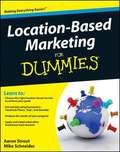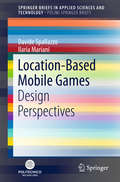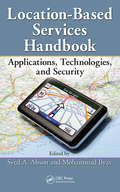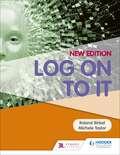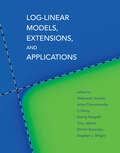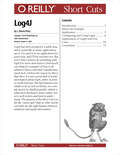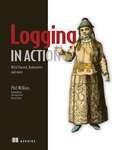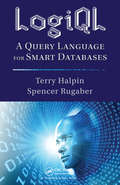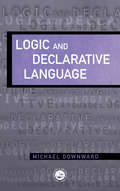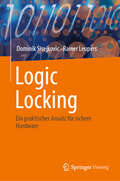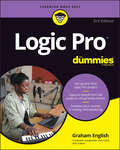- Table View
- List View
Location-Based Marketing For Dummies
by Aaron Strout Mike SchneiderLearn to create a two-way dialog with customers with location-based services and smartphones Location-based services (LBS) have started to gain popularity in the marketplace with more and more businesses starting to incorporate LBS into their marketing mix. This book is a necessary resource for anyone eager to create a two-way dialog with their customers in order to establish customer loyalty programs, drive promotions, or encourage new visitors. You'll learn how to successfully build, launch, and measure a location-based marketing program and figure out which location-based services are right for your business. Packed with resources that share additional information, this helpful guide walks you through the tools and techniques needed to measure all the data that results from a successful location-based marketing program. Serves as an ideal introduction to location-based marketing and gets you started building a location-based marketing program Helps you figure out which location-based service (LBS) is right for your business and then integrate LBS with your social graph Details ways to create compelling offers, using location-based marketing as a customer loyalty program, and set performance goals and benchmarks Explains how to use tools to measure your campaign, analyze results, and determine your business's success Includes examples of companies that are successfully using location-based marketing to demonstrate techniques and concepts featured in the book No matter your location, location-based services can benefit your business and this For Dummies book shows you how!
Location-Based Mobile Games: Design Perspectives (SpringerBriefs in Applied Sciences and Technology)
by Davide Spallazzo Ilaria MarianiThis book approaches Location Based Mobile Games from a design perspective, investigating the peculiar traits that make them compelling contemporary practices and challenging fields of investigation. Relying on an interdisciplinary theoretical background and empirical studies, it delves into LBMGs’ intertwining theoretical assumptions and describes their translation into practice. The authors examine these games from different perspectives, exploring how they can impact the way we look at our surroundings, their influence on our social dimension, their ability to translate a wide range of information into a game experience, and the negotiations they activate by intertwining two realities. Each issue is addressed from a twofold perspective: that of the designers who craft the games, and that of the users who interpret the designers’ choices and take part in the game experience. In so doing, the book covers the relationship between processes of designing and playing, investigating games that communicate through meaningful interactions, share perspectives as forms of narratives, and integrate physicality and surroundings in the play activity. The reasoning advanced throughout the chapters will benefit researchers, designers and entrepreneurs in the field, as it provides a novel perspective on LBMGs, seeks to increase designers’ awareness of often-neglected issues, and suggests interpretations and practices that can impact how commercial games are designed.
Location-Based Services Handbook: Applications, Technologies, and Security
by Mohammad Ilyas Syed A. AhsonLocation-Based Services Handbook: Applications, Technologies, and Security is a comprehensive reference containing all aspects of essential technical information on location-based services (LBS) technology. With broad coverage ranging from basic concepts to research-grade material, it presents a much-needed overview of technologies for positioning and localizing, including range- and proximity-based localization methods, and environment-based location estimation methods. Featuring valuable contributions from field experts around the world, this book addresses existing and future directions of LBS technology, exploring how it can be used to optimize resource allocation and improve cooperation in wireless networks. It is a self-contained, comprehensive resource that presents: A detailed description of the wireless location positioning technology used in LBS Coverage of the privacy and protection procedure for cellular networks—and its shortcomings An assessment of threats presented when location information is divulged to unauthorized parties Important IP Multimedia Subsystem and IMS-based presence service proposals The demand for navigation services is predicted to rise by a combined annual growth rate of more than 104 percent between 2008 and 2012, and many of these applications require efficient and highly scalable system architecture and system services to support dissemination of location-dependent resources and information to a large and growing number of mobile users. This book offers tools to aid in determining the optimal distance measurement system for a given situation by assessing factors including complexity, accuracy, and environment. It provides an extensive survey of existing literature and proposes a novel, widely applicable, and highly scalable architecture solution. Organized into three major sections—applications, technologies, and security—this material fully covers various location-based applications and the impact they will have on the future.
Locative Media (Routledge Studies in New Media and Cyberculture)
by Gerard Goggin Rowan WilkenNot only is locative media one of the fastest growing areas in digital technology, but questions of location and location-awareness are increasingly central to our contemporary engagements with online and mobile media, and indeed media and culture generally. This volume is a comprehensive account of the various location-based technologies, services, applications, and cultures, as media, with an aim to identify, inventory, explore, and critique their cultural, economic, political, social, and policy dimensions internationally. In particular, the collection is organized around the perception that the growth of locative media gives rise to a number of crucial questions concerning the areas of culture, economy, and policy.
Lockdown Parenting Fails: (Because it's not all f*cking rainbows!)
by Nathan JoyceDid your home haircut make your child look like Friar Tuck?Did you forget to put bananas in your banana bread?Did your primary-schooler have to correct your times tables?Then you were probably one of many people trying your f*cking hardest to parent during lockdown, and so now deserve a medal (or a case of gin).Featuring entries from fellow survivors on the horrors of homeschooling, the nightmares of kitchen experiments, the fallibility of trying to keep your colleagues' respect, the inevitability of putting on all the weight and the joys of considering what you did to make the world punish you so......Lockdown Parenting Fails is a hilarious (and trauma-inducing) collection of the best memories from the worst time in everyone's lives.
Locksport: A Hackers Guide to Lockpicking, Impressioning, and Safe Cracking
by Matt Burrough Jos Weyers Walter Belgers BandEAtoZ Nigel TolleyA comprehensive, fully illustrated guide to the fascinating sport of picking locks, Locksport is authored by five of the field&’s foremost champions. Together, they&’ll show you how to ethically, efficiently, and effectively bypass anything—from simple locks and safe dials to deadlocks and vaults.Welcome to the world of locksport, the sport of defeating locks. Whether you&’re new to the challenge of lockpicking or aiming for championship gold, this book serves as your definitive guide, packed with practical advice from a team of experts.DIVE INTO THE ESSENTIALS WITH LOCKSPORT FOUNDATIONSHow various locks work and how to maintain and disassemble practice locks What makes some locks more secure than othersThe laws, competitions, and communities that make up the world of locksportMASTER YOUR CRAFT WITH HANDS-ON TECHNIQUESHow to pick pin tumblers and lever locks, make impressions or craft a working key from a blank, and manipulate open combination safe locks How to work with picks, rakes, tension wrenches, files, magnification tools, safe-lock graphs, and depth-measuring instrumentsThe intricacies of security pins, wards, dimple locks, keyways, and antique locksGAIN THE COMPETITIVE EDGE WITH COMPETITION INSIGHTSThe ins and outs of competition setup and tools and how to host your own competitions Expert strategies for managing your nerves and gathering lock intelWhat it&’s like to participate in timed head-to-head competitions, PicTacToe™, escape challenges, and other lockpicking contestsFrom mastering your first padlock to conquering a competition, Locksport will show you how to take your skills to the next level—and have endless fun doing it.
Loewy Decomposition of Linear Differential Equations
by Fritz SchwarzThe central subject of the book is the generalization of Loewy's decomposition - originally introduced by him for linear ordinary differential equations - to linear partial differential equations. Equations for a single function in two independent variables of order two or three are comprehensively discussed. A complete list of possible solution types is given. Various ad hoc results available in the literature are obtained algorithmically. The border of decidability for generating a Loewy decomposition are explicitly stated. The methods applied may be generalized in an obvious way to equations of higher order, in more variables or systems of such equations.
Log on to IT
by Roland Birbal (IT) Michele TaylorDevelop IT skills through an active, accessible approach to theory and practice, providing an ideal foundation for lower secondary students going on to study IT at CSEC® and for building real-life computer skills; fully updated to reflect the new curriculum and new approaches to IT teaching.- Build knowledge with straightforward introductions to theoretical concepts, key practical applications and new topics such as ethical use of computers and multimedia.- Support all learning styles with a range of questions - Multiple Choice, True or False, Short Answer, Research, Project and a fun Crossword puzzle.- Develop critical thinking and research skills with research projects.The answers can be found here: www.hoddereducation.co.uk/Log-on-to-IT-Answers
Log on to IT for CSEC
by Roland Birbal (IT) Michele TaylorBenefit from expert guidance in this new edition of a tried and trusted approach; updated to reflect the new CSEC® IT curriculum, it provides an engaging and accessible approach to theory and practice.- Prepare for SBA with advice and guidance and a full sample SBA project and suggested solution at the end of Chapter 16.- Consolidate learning through a range of question types such as Multiple Choice, True or False, Short Answer, Research, Project and a fun Crossword puzzle.- Confidently cover new topics and emerging technology with straightforward explanations and numerous examples.The answers can be found here: www.hoddereducation.co.uk/Log-on-to-IT-Answers
Log-Linear Models, Extensions, and Applications (Neural Information Processing Series)
by Li Deng Aleksandr Aravkin Anna Choromanska Georg Heigold Tony JebaraAdvances in training models with log-linear structures, with topics including variable selection, the geometry of neural nets, and applications. Log-linear models play a key role in modern big data and machine learning applications. From simple binary classification models through partition functions, conditional random fields, and neural nets, log-linear structure is closely related to performance in certain applications and influences fitting techniques used to train models. This volume covers recent advances in training models with log-linear structures, covering the underlying geometry, optimization techniques, and multiple applications. The first chapter shows readers the inner workings of machine learning, providing insights into the geometry of log-linear and neural net models. The other chapters range from introductory material to optimization techniques to involved use cases. The book, which grew out of a NIPS workshop, is suitable for graduate students doing research in machine learning, in particular deep learning, variable selection, and applications to speech recognition. The contributors come from academia and industry, allowing readers to view the field from both perspectives. Contributors Aleksandr Aravkin, Avishy Carmi, Guillermo A. Cecchi, Anna Choromanska, Li Deng, Xinwei Deng, Jean Honorio, Tony Jebara, Huijing Jiang, Dimitri Kanevsky, Brian Kingsbury, Fabrice Lambert, Aurélie C. Lozano, Daniel Moskovich, Yuriy S. Polyakov, Bhuvana Ramabhadran, Irina Rish, Dimitris Samaras, Tara N. Sainath, Hagen Soltau, Serge F. Timashev, Ewout van den Berg
Log4J
by J. Steven PerryLog4j has been around for a while now, and it seems like so many applications use it. I've used it in my applications for years now, and I'll bet you have too. But every time I need to do something with log4j I've never done before I find myself searching for examples of how to do whatever that is, and I don't usually have much luck. I believe the reason for this is that there is a not a great deal of useful information about log4j, either in print or on the Internet. The information is too simple to be of real-world use, too complicated to be distilled quickly (which is what most developers want) and/or not very well written and hard to understand. The purpose of this Short Cut is to hit the "sweet spot" that no other works currently do: the right balance between simplicity and useful information.The code for this Short Cut is available at the code example repository.
Logging Off: The Human Cost of Our Digital World
by Adele Zeynep Walton'You won't look at your screens in the same way after reading this book' Grace Blakeley, author of VULTURE CAPITALISM 'Logging Off is a life-saving book' Mikaela Loach, author of IT'S NOT THAT RADICAL'A harrowing but important read' Carole CadwalladrWe live in a digital world. In the 30 years since we've been online, we've created connections, crossed boundaries and discovered new worlds. We have done things generations before us could never have imagined. But at what cost?Growing up as a Gen Z, Adele spent endless hours as a teenager on social media, shaping her view of herself and the world. As a freelance journalist, she has used her social media platforms and digital technology to develop a career in an unfamiliar and competitive industry, benefitting from the opportunities that these spaces can offer. But after losing her sister to online harms, she realised that our current digital world is failing us.We are an anxious and discontent generation. Our lived realities and our online vulnerabilities are inextricably linked, and this means big business for social media tycoons who want us to stay scrolling at any cost. As Big Tech barons make their billions, capitalising on our emotions, instincts, insecurities and desires, everyday people are losing out.From workers being fired by algorithms, to online forums dedicated to revenge porn and encouraging suicide, to censorship of marginalised voices and the turbulent impacts of AI, Logging Off reveals that our digital world is currently fuelling crises that only empathy, agency and humanity can resolve. This book is a call for a radical reclamation of our digital world, for a more humane future that empowers us all.'Poignant, timely and astute, Logging Off is a compelling examination of how our lives have been shaped - and irrevocably changed - by the rise of digital technologies' Yomi Adegoke, author of THE LIST
Logging Off: The Human Cost of Our Digital World
by Adele Zeynep Walton'You won't look at your screens in the same way after reading this book' Grace Blakeley, author of VULTURE CAPITALISM 'Logging Off is a life-saving book' Mikaela Loach, author of IT'S NOT THAT RADICAL'A harrowing but important read' Carole CadwalladrWe live in a digital world. In the 30 years since we've been online, we've created connections, crossed boundaries and discovered new worlds. We have done things generations before us could never have imagined. But at what cost?Growing up as a Gen Z, Adele spent endless hours as a teenager on social media, shaping her view of herself and the world. As a freelance journalist, she has used her social media platforms and digital technology to develop a career in an unfamiliar and competitive industry, benefitting from the opportunities that these spaces can offer. But after losing her sister to online harms, she realised that our current digital world is failing us.We are an anxious and discontent generation. Our lived realities and our online vulnerabilities are inextricably linked, and this means big business for social media tycoons who want us to stay scrolling at any cost. As Big Tech barons make their billions, capitalising on our emotions, instincts, insecurities and desires, everyday people are losing out.From workers being fired by algorithms, to online forums dedicated to revenge porn and encouraging suicide, to censorship of marginalised voices and the turbulent impacts of AI, Logging Off reveals that our digital world is currently fuelling crises that only empathy, agency and humanity can resolve. This book is a call for a radical reclamation of our digital world, for a more humane future that empowers us all.'Poignant, timely and astute, Logging Off is a compelling examination of how our lives have been shaped - and irrevocably changed - by the rise of digital technologies' Yomi Adegoke, author of THE LIST
Logging in Action: With Fluentd, Kubernetes and more
by Phil WilkinsMake log processing a real asset to your organization with powerful and free open source tools.In Logging in Action you will learn how to: Deploy Fluentd and Fluent Bit into traditional on-premises, IoT, hybrid, cloud, and multi-cloud environments, both small and hyperscaled Configure Fluentd and Fluent Bit to solve common log management problems Use Fluentd within Kubernetes and Docker services Connect a custom log source or destination with Fluentd&’s extensible plugin framework Logging best practices and common pitfalls Logging in Action is a guide to optimize and organize logging using the CNCF Fluentd and Fluent Bit projects. You&’ll use the powerful log management tool Fluentd to solve common log management, and learn how proper log management can improve performance and make management of software and infrastructure solutions easier. Through useful examples like sending log-driven events to Slack, you&’ll get hands-on experience applying structure to your unstructured data. About the technology Don&’t fly blind! An effective logging system can help you see and correct problems before they cripple your software. With the Fluentd log management tool, it&’s a snap to monitor the behavior and health of your software and infrastructure in real time. Designed to collect and process log data from multiple sources using the industry-standard JSON format, Fluentd delivers a truly unified logging layer across all your systems. About the book Logging in Action teaches you to record and analyze application and infrastructure data using Fluentd. Using clear, relevant examples, it shows you exactly how to transform raw system data into a unified stream of actionable information. You&’ll discover how logging configuration impacts the way your system functions and set up Fluentd to handle data from legacy IT environments, local data centers, and massive Kubernetes-driven distributed systems. You&’ll even learn how to implement complex log parsing with RegEx and output events to MongoDB and Slack. What's inside Capture log events from a wide range of systems and software, including Kubernetes and Docker Connect to custom log sources and destinations Employ Fluentd&’s extensible plugin framework Create a custom plugin for niche problems About the reader For developers, architects, and operations professionals familiar with the basics of monitoring and logging. About the author Phil Wilkins has spent over 30 years in the software industry. Has worked for small startups through to international brands. Table of Contents PART 1 FROM ZERO TO &“HELLO WORLD&” 1 Introduction to Fluentd 2 Concepts, architecture, and deployment of Fluentd PART 2 FLUENTD IN DEPTH 3 Using Fluentd to capture log events 4 Using Fluentd to output log events 5 Routing log events 6 Filtering and extrapolation PART 3 BEYOND THE BASICS 7 Performance and scaling 8 Driving logs with Docker and Kubernetes 9 Creating custom plugins PART 4 GOOD LOGGING PRACTICES AND FRAMEWORKS TO MAXIMIZE LOG VALUE 10 Logging best practices 11 Logging frameworks
LogiQL: A Query Language for Smart Databases (Emerging Directions in Database Systems and Applications)
by Terry Halpin Spencer RugaberLogiQL is a new state-of-the-art programming language based on Datalog. It can be used to build applications that combine transactional, analytical, graph, probabilistic, and mathematical programming. LogiQL makes it possible to build hybrid applications that previously required multiple programming languages and databases. In this first book to co
Logic And Declarative Language
by M. DownwardLogic has acquired a reputation for difficulty, perhaps because many of the approaches adopted have been more suitable for mathematicians than computer scientists. This book shows that the subject is not inherently difficult and that the connections between logic and declarative language are straightforward. Many exercises have been included in the hope that these will lead to a much greater confidence in manual proofs, therefore leading to a greater confidence in automated proofs.
Logic Circuit Design
by Shimon P. VingronIn three main divisions the book covers combinational circuits, latches, and asynchronous sequential circuits. Combinational circuits have no memorising ability, while sequential circuits have such an ability to various degrees. Latches are the simplest sequential circuits, ones with the shortest memory. The presentation is decidedly non-standard. The design of combinational circuits is discussed in an orthodox manner using normal forms and in an unorthodox manner using set-theoretical evaluation formulas relying heavily on Karnaugh maps. The latter approach allows for a new design technique called composition. Latches are covered very extensively. Their memory functions are expressed mathematically in a time-independent manner allowing the use of (normal, non-temporal) Boolean logic in their calculation. The theory of latches is then used as the basis for calculating asynchronous circuits. Asynchronous circuits are specified in a tree-representation, each internal node of the tree representing an internal latch of the circuit, the latches specified by the tree itself. The tree specification allows solutions of formidable problems such as algorithmic state assignment, finding equivalent states non-recursively, and verifying asynchronous circuits.
Logic Circuit Design: Selected Topics and Methods
by Shimon P. VingronThe 2nd edition has been thoroughly revised and is intended as a wakeup call in the stagnant and dormant field of switching algebra and logic circuit design. It presents the material in a concise but thorough way. The topics selected are an in-depth presentation of switching algebra, a theory of memory circuits (sometimes called flop flops), a new approach to asynchronous circuits, and a newly added part presenting a unique programming technique (or language) for programmable logic controllers (PLCs). Be ready for the unorthodox and controversial.
Logic Functions and Equations: Binary Models For Computer Science
by Christian Posthoff Bernd Steinbach<P><P>The field of binary Logics has two main areas of application, the Digital Design of Circuits (related to Electrical Engineering) and Propositional Logics (related to Mathematics, Artificial Intelligence, Complexity etc.). In both cases it is quite possible to teach the theoretical foundations and to do some exercises, but in both cases the examples that can be done in class and by hand are far away from examples that are relevant for practical problems. Therefore a software package called XBOOLE Monitor will be made available (downloadable, without additional fees), and the exercises given in Logic Functions and Equations can be solved by using this software package – in this way it is possible to solve a lot of relevant problems and to study the solutions based on this software. <P><P> The whole approach is based on the single and unique concept of Boolean Equations and Ternary Vectors as the basic data structure which makes it also easy to follow these ideas very easily, because the wide range of problems and solutions will be based on these two concepts.
Logic Functions and Equations: Fundamentals and Applications using the XBOOLE-Monitor
by Christian Posthoff Bernd SteinbachThe greatly expanded and updated 3rd edition of this textbook offers the reader a comprehensive introduction to the concepts of logic functions and equations and their applications across computer science and engineering. The authors’ approach emphasizes a thorough understanding of the fundamental principles as well as numerical and computer-based solution methods. The book provides insight into applications across propositional logic, binary arithmetic, coding, cryptography, complexity, logic design, and artificial intelligence.Updated throughout, some major additions for the 3rd edition include:a new chapter about the concepts contributing to the power of XBOOLE;a new chapter that introduces into the application of the XBOOLE-Monitor XBM 2;many tasks that support the readers in amplifying the learned content at the end of the chapters;solutions of a large subset of these tasks to confirm learning success;challenging tasks that need the power of the XBOOLE software for their solution.The XBOOLE-monitor XBM 2 software is used to solve the exercises; in this way the time-consuming and error-prone manipulation on the bit level is moved to an ordinary PC, more realistic tasks can be solved, and the challenges of thinking about algorithms leads to a higher level of education.
Logic Locking: Ein praktischer Ansatz für sichere Hardware
by Rainer Leupers Dominik SisejkovicEine subtile Veränderung, die zu katastrophalen Folgen führt - Hardware-Trojaner stellen zweifellos eine der größten Sicherheitsbedrohungen des modernen Zeitalters dar. Wie kann die Hardware vor diesen bösartigen Veränderungen geschützt werden? Eine mögliche Lösung verbirgt sich im Logic Locking, einer bekannten Technik zur Verschleierung von Hardware. In diesem Buch gehen wir Schritt für Schritt vor, um Logic Locking zu verstehen, von seiner grundlegenden Mechanik über die Implementierung in Software bis hin zu einer eingehenden Analyse der Sicherheitseigenschaften im Zeitalter des maschinellen Lernens. Dieses Buch kann als Nachschlagewerk sowohl für Anfänger als auch für Experten verwendet werden, die in die Welt des logischen Sperrens eintauchen wollen und dabei einen ganzheitlichen Überblick über die gesamte Infrastruktur erhalten möchten, die für den Entwurf, die Bewertung und den Einsatz moderner Sperrstrategien erforderlich ist.
Logic Primer
by Colin Allen Michael HandLogic Primer presents a rigorous introduction to natural deduction systems of sentential and first-order logic. Logic Primer presents a rigorous introduction to natural deduction systems of sentential and first-order logic. The text is designed to foster the student-instructor relationship. The key concepts are laid out in concise definitions and comments, with the expectation that the instructor will elaborate upon them. New to the second edition is the addition of material on the logic of identity in chapters 3 and 4. An innovative interactive Web site, consisting of a "Logic Daemon" and a "Quizmaster," encourages students to formulate their own proofs and links them to appropriate explanations in the book.
Logic Pro For Dummies
by Graham EnglishThis one-stop source for Logic Pro insight helps you spend more time creating music Every minute you spend trying to figure out how to set up a new track or build a drum loop is a minute you don’t spend creating and recording your music. This guide to the recording software favored by Mac users helps you bypass the time needed to search for tech answers and spend more time capturing sounds. Discover the full recording power of Logic Pro, starting with launching a project and recording your audio. Explore the built-in digital instruments and beat makers, augment your recording power with plug-ins, and finalize your song by editing, adding effects, mixing, mastering, and sharing. The final step is music stardom! Learn your way around the Logic Pro interface and understand the workflow Set up your project and add tracks and regions Record acoustic audio or conduct your orchestra of MIDI instruments Edit, mix, automate, export, and feel proud of your audio filesFor beginning music creators and producers, this Dummies guide makes it simple to get started with Logic Pro.
Logic Pro X 10. 3 - Apple Pro Training Series: Professional Music Production (Apple Pro Training )
by David Nahmani<P>The Apple-Certified Way to Learn <P>Record, arrange, mix, produce, and polish your music with this bestselling, Apple-certified guide to Logic Pro X 10.3. Veteran producer and composer David Nahmani uses step-by-step, project-based instructions and straightforward explanations to teach everything from basic music creation to sophisticated production techniques. Using the book’s downloadable lesson files and Logic Pro X, you’ll begin making music in the first lesson. <P>From there, you’ll learn to record audio and MIDI, create and edit sequences, and master mixing and automation techniques such as submixing with Track Stacks or the practical uses of true stereo panning. You will create both acoustic and electronic virtual drum performances using Drummer tracks with Drum Kit Designer and Drum Machine Designer. You’ll use Logic Pro X MIDI plug-ins and Smart Controls to control software synthesizers from a MIDI controller or an iPad. Flex Time will allow you to precisely edit the timing of notes inside an audio recording, and you’ll explore Flex Pitch to correct the pitch of a vocal recording. Finally, you’ll mix, automate, and master the song, using plug-ins to process only selected sections or entire tracks, giving your audio creations the final polish needed to achieve a professional sound. <P>Downloadable lesson and media files allow you to perform the hands-on exercises. <br>Focused lessons take you step by step through practical, real-world tasks. <br>Ample illustrations help you master techniques fast. <br>Lesson goals and time estimates help you plan your time. <br>Chapter review questions help you prepare for the Logic Pro X 10.3 certification exam. <P>The Apple Pro Training Series is both a self-paced learning tool and the official curriculum of the Apple Training and Certification program. Upon completing the course material in this guide, you can become Apple Certified by passing the Logic Pro X 10.3 certification exam at an Apple Authorized Training Provider. To find an Apple Authorized Training Provider near you, please visit training.apple.com. <P>Also in the Apple Pro Training Series: <br>Final Cut Pro X 10.3 <br>Pages, Numbers, and Keynote <br>macOS Support Essentials
Logic Pro X 10. 4 - Apple Pro Training Series: Professional Music Production (Apple Pro Training)
by David NahmaniRecord, arrange, mix, produce, and polish your audio files with this best-selling, Apple-certified guide to Logic Pro X 10.4. Veteran producer and composer David Nahmani uses step-bystep, project-based instructions and straightforward explanations to teach everything from basic music creation to sophisticated production techniques. Using the book’s downloadable lesson files and Logic Pro X, you’ll begin making music in the first lesson. From there, learn to record audio and MIDI data, create and edit sequences, and master mixing and automation techniques such as submixing with track stacks. Create both acoustic and electronic virtual drum performances using Drummer tracks with Drum Kit Designer and Drum Machine Designer. Use Logic Pro X MIDI FX and Smart Controls to control software synthesizers from a MIDI controller or an iPad. Harness the power of Smart Tempo to make sure all recordings, imported audio files, and samples play in time. Flex Time allows you to precisely edit the timing of notes inside an audio recording, and you’ll explore Flex Pitch to correct the pitch of a vocal recording. Finally, you mix, automate, and master the song, using plug-ins to process only selected sections or entire tracks, giving your audio creations the final polish needed to achieve a professional sound. Downloadable lesson and media files allow you to perform the hands-on exercises. Focused lessons take you step by step through practical, real-world tasks. Accessible writing style puts an expert instructor at your side Ample illustrations help you master techniques fast. Lesson goals and time estimates help you plan your time. Chapter review questions summarize what you’ve learned and help you prepare for the Apple certification exam.
